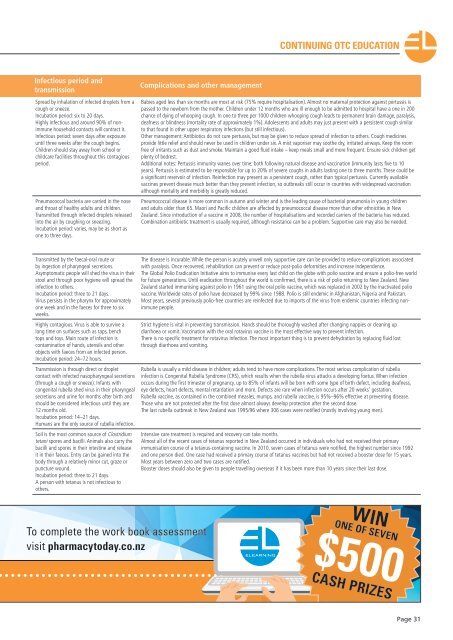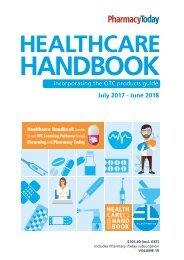2017 HCHB_digital
Create successful ePaper yourself
Turn your PDF publications into a flip-book with our unique Google optimized e-Paper software.
CONTINUING OTC EDUCATION<br />
Infectious period and<br />
transmission<br />
Spread by inhalation of infected droplets from a<br />
cough or sneeze.<br />
Incubation period: six to 20 days.<br />
Highly infectious and around 90% of nonimmune<br />
household contacts will contract it.<br />
Infectious period: seven days after exposure<br />
until three weeks after the cough begins.<br />
Children should stay away from school or<br />
childcare facilities throughout this contagious<br />
period.<br />
Pneumococcal bacteria are carried in the nose<br />
and throat of healthy adults and children.<br />
Transmitted through infected droplets released<br />
into the air by coughing or sneezing.<br />
Incubation period: varies, may be as short as<br />
one to three days.<br />
Complications and other management<br />
Babies aged less than six months are most at risk (75% require hospitalisation). Almost no maternal protection against pertussis is<br />
passed to the newborn from the mother. Children under 12 months who are ill enough to be admitted to hospital have a one in 200<br />
chance of dying of whooping cough. In one to three per 1000 children whooping cough leads to permanent brain damage, paralysis,<br />
deafness or blindness (mortality rate of approximately 1%). Adolescents and adults may just present with a persistent cough similar<br />
to that found in other upper respiratory infections (but still infectious).<br />
Other management: Antibiotics do not cure pertussis, but may be given to reduce spread of infection to others. Cough medicines<br />
provide little relief and should never be used in children under six. A mist vaporiser may soothe dry, irritated airways. Keep the room<br />
free of irritants such as dust and smoke. Maintain a good fluid intake – keep meals small and more frequent. Ensure sick children get<br />
plenty of bedrest.<br />
Additional notes: Pertussis immunity wanes over time; both following natural disease and vaccination (immunity lasts five to 10<br />
years). Pertussis is estimated to be responsible for up to 20% of severe coughs in adults lasting one to three months. These could be<br />
a significant reservoir of infection. Reinfection may present as a persistent cough, rather than typical pertussis. Currently available<br />
vaccines prevent disease much better than they prevent infection, so outbreaks still occur in countries with widespread vaccination<br />
although mortality and morbidity is greatly reduced.<br />
Pneumococcal disease is more common in autumn and winter and is the leading cause of bacterial pneumonia in young children<br />
and adults older than 65. Maori and Pacific children are affected by pneumococcal disease more than other ethnicities in New<br />
Zealand. Since introduction of a vaccine in 2008, the number of hospitalisations and recorded carriers of the bacteria has reduced.<br />
Combination antibiotic treatment is usually required, although resistance can be a problem. Supportive care may also be needed.<br />
Transmitted by the faecal-oral route or<br />
by ingestion of pharyngeal secretions.<br />
Asymptomatic people will shed the virus in their<br />
stool and through poor hygiene will spread the<br />
infection to others.<br />
Incubation period: three to 21 days.<br />
Virus persists in the pharynx for approximately<br />
one week and in the faeces for three to six<br />
weeks.<br />
Highly contagious. Virus is able to survive a<br />
long time on surfaces such as taps, bench<br />
tops and toys. Main route of infection is<br />
contamination of hands, utensils and other<br />
objects with faeces from an infected person.<br />
Incubation period: 24–72 hours.<br />
Transmission is through direct or droplet<br />
contact with infected nasopharyngeal secretions<br />
(through a cough or sneeze). Infants with<br />
congenital rubella shed virus in their pharyngeal<br />
secretions and urine for months after birth and<br />
should be considered infectious until they are<br />
12 months old.<br />
Incubation period: 14–21 days.<br />
Humans are the only source of rubella infection.<br />
Soil is the most common source of Clostridium<br />
tetani spores and bacilli. Animals also carry the<br />
bacilli and spores in their intestine and release<br />
it in their faeces. Entry can be gained into the<br />
body through a relatively minor cut, graze or<br />
puncture wound.<br />
Incubation period: three to 21 days.<br />
A person with tetanus is not infectious to<br />
others.<br />
The disease is incurable. While the person is acutely unwell only supportive care can be provided to reduce complications associated<br />
with paralysis. Once recovered, rehabilitation can prevent or reduce post-polio deformities and increase independence.<br />
The Global Polio Eradication Initiative aims to immunise every last child on the globe with polio vaccine and ensure a polio-free world<br />
for future generations. Until eradication throughout the world is confirmed, there is a risk of polio returning to New Zealand. New<br />
Zealand started immunising against polio in 1961 using the oral polio vaccine, which was replaced in 2002 by the inactivated polio<br />
vaccine. Worldwide rates of polio have decreased by 99% since 1988. Polio is still endemic in Afghanistan, Nigeria and Pakistan.<br />
Most years, several previously polio-free countries are reinfected due to imports of the virus from endemic countries infecting nonimmune<br />
people.<br />
Strict hygiene is vital in preventing transmission. Hands should be thoroughly washed after changing nappies or cleaning up<br />
diarrhoea or vomit. Vaccination with the oral rotavirus vaccine is the most effective way to prevent infection.<br />
There is no specific treatment for rotavirus infection. The most important thing is to prevent dehydration by replacing fluid lost<br />
through diarrhoea and vomiting.<br />
Rubella is usually a mild disease in children; adults tend to have more complications. The most serious complication of rubella<br />
infection is Congenital Rubella Syndrome (CRS), which results when the rubella virus attacks a developing foetus. When infection<br />
occurs during the first trimester of pregnancy, up to 85% of infants will be born with some type of birth defect, including deafness,<br />
eye defects, heart defects, mental retardation and more. Defects are rare when infection occurs after 20 weeks’ gestation.<br />
Rubella vaccine, as contained in the combined measles, mumps, and rubella vaccine, is 95%–96% effective at preventing disease.<br />
Those who are not protected after the first dose almost always develop protection after the second dose.<br />
The last rubella outbreak in New Zealand was 1995/96 where 306 cases were notified (mostly involving young men).<br />
Intensive care treatment is required and recovery can take months.<br />
Almost all of the recent cases of tetanus reported in New Zealand occurred in individuals who had not received their primary<br />
immunisation course of a tetanus-containing vaccine. In 2010, seven cases of tetanus were notified, the highest number since 1992<br />
and one person died. One case had received a primary course of tetanus vaccines but had not received a booster dose for 15 years.<br />
Most years between zero and two cases are notified.<br />
Booster doses should also be given to people travelling overseas if it has been more than 10 years since their last dose.<br />
To complete the work book assessment<br />
visit pharmacytoday.co.nz<br />
WIN<br />
ONE OF SEVEN<br />
$500<br />
CASH PRIZES<br />
Page 31



